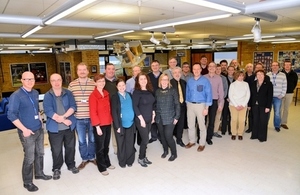UK-built tech brings Europe’s Mercury mission closer to launch
UK-built instrument shipped to the European Space Agency to be integrated with the BepiColombo spacecraft.

MIXS team with ESA and UK Space Agency officials.
A UK-built instrument, designed to unlock the secrets of Mercury’s surface, has today (15 May 2015) been shipped from the University of Leicester’s Space Research Centre to the European Space Agency where it will be integrated with the BepiColombo spacecraft.
The Mercury Imaging X-ray Spectrometer (MIXS) is one of the main instruments on the upcoming BepiColombo Mercury mission, due for launch in 2017. Funded by the UK Space Agency, the instrument will use novel X-ray optics to determine small-scale features on Mercury and find out what the planet’s surface is made of. It will do this by measuring fluorescent X-rays that come from the planet’s surface, excited by high energy X-rays from the Sun, to identify chemical elements. The findings from the instrument could help explain how the planet formed during the early history of the Solar System.
In addition to the UK delivering the MIXS instrument, much of the BepiColombo spacecraft is also being built in the UK at Airbus Defence and Space in Stevenage and UK companies are also holding contracts for several other components of the mission.
Dr David Parker, Chief Executive of the UK Space Agency, said:
The MIXS instrument for BepiColombo is an excellent example of the novel technology that is being designed and built in the UK for international space missions. The UK’s considerable skill in new technology development is not only allowing us to explore our solar system but is securing valuable contracts for UK industry whilst often creating products that can also be applied to other industries.
BepiColombo will be only the third spacecraft to visit Mercury in the history of space exploration. Mercury’s harsh environment makes it a particularly challenging mission as the spacecraft will have to endure intense sunlight and temperatures up to 350°C while gathering data. The missions science goals are crucial to our understanding of how planetary surfaces are formed in general, and how they evolve and change over time – not only allowing us to piece together the history of our solar system but to place our own planetary environment into context.
Emma Bunce, Professor of Planetary Plasma Physics at the University of Leicester, and MIXS Principal Investigator, said:
The team have worked incredibly hard over many years and in particular throughout the last year, to design and build such a complex instrument. It has been a very challenging project from a technical point of view, as the instrument needs to survive extreme temperatures at the orbit of Mercury, perilously close to the Sun. The fact that we have got this far, and are delivering our flight model instrument that will go to Mercury to allow us to do such great new science, is entirely due to the dedication of our fantastic technical team.
David Rothery, Professor of Planetary Geosciences at the Open University, who is lead Co-Investigator on MIXS and also leads the European Space Agency’s ‘Mercury Surface & Composition Working Group’ said:
NASA’s MESSENGER mission that ended two weeks ago showed us that Mercury is a misfit planet. There’s so much about it that we didn’t expect and that we don’t understand. MIXS is one of the instruments for BepiColombo that will help us sort things out.
BepiColombo will consist of three sections: a Mercury Transfer Module (MTM) - designed to get the spacecraft to the planet - and two orbiters: the European Mercury Planetary Orbiter (MPO) and the Japanese Mercury Magnetospheric Orbiter (MMO).
ESA is responsible for the larger MPO. Its 11 scientific instruments will study Mercury from a low-polar-orbit.